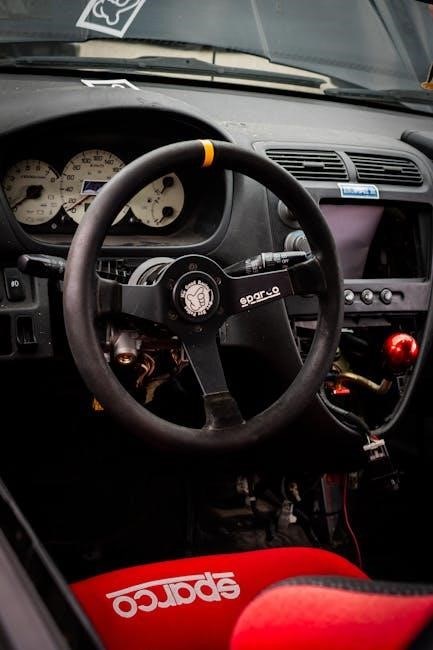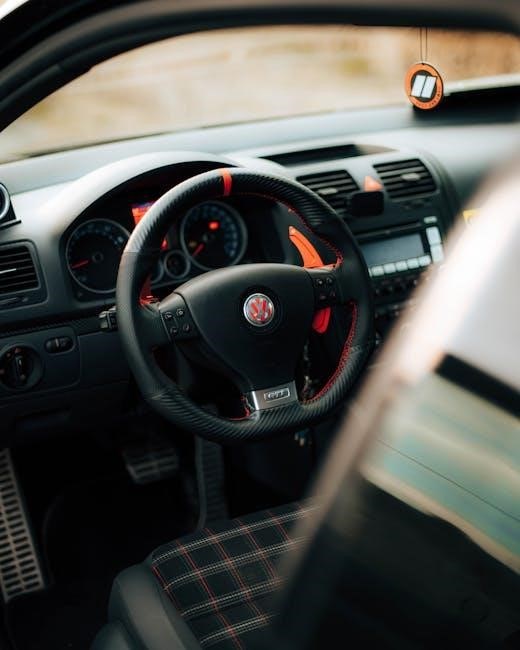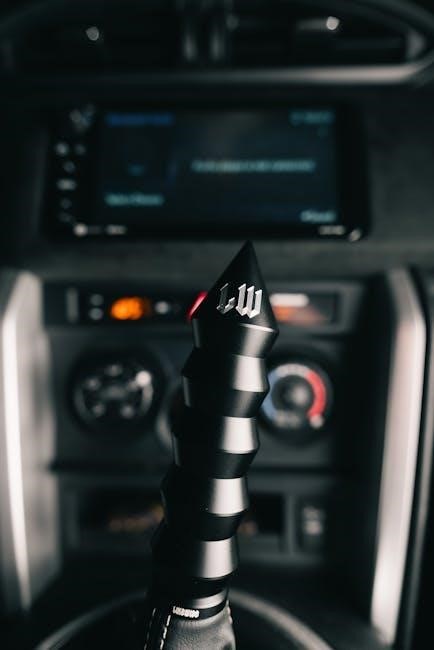
The 9-speed manual transmission is a modern innovation designed to optimize performance and efficiency‚ offering precise control and smooth shifting across a wide range of driving conditions.
By integrating advanced gear ratios‚ it enhances fuel efficiency and driver engagement‚ making it a preferred choice for both everyday commuting and enthusiast driving experiences.
Overview of Manual Transmissions
Manual transmissions are driver-operated systems that enable gear changes through a clutch and gearshift‚ offering precise control over speed and torque. These systems rely on mechanical components like the clutch‚ flywheel‚ and gearsets to transfer power from the engine to the wheels. Unlike automatic transmissions‚ manuals require active driver engagement‚ making them popular for performance and fuel efficiency. They are typically lighter‚ more cost-effective‚ and provide a direct connection to the vehicle‚ enhancing the driving experience. Modern manual transmissions‚ such as the 9-speed‚ have evolved to include advanced features for smoother shifting and improved performance;
Importance of Gear Ratios in Modern Vehicles

Gear ratios are crucial for optimizing performance‚ fuel efficiency‚ and drivability in modern vehicles. They determine how power and torque are delivered across different speeds‚ enabling smooth acceleration and control. In a 9-speed manual transmission‚ the wide range of gear ratios allows drivers to maintain optimal engine speed in various driving conditions‚ from city traffic to highway cruising. Properly calibrated ratios ensure efficient power delivery‚ reduce engine strain‚ and enhance overall vehicle responsiveness‚ making them essential for both everyday driving and high-performance applications.
Evolution of Manual Transmissions
Manual transmissions have evolved significantly since their inception in the early 20th century. Early systems featured basic 3- or 4-speed designs‚ focused on simplicity and durability. Over decades‚ advancements in engineering led to 5-‚ 6-‚ and eventually 9-speed manuals‚ offering improved gear spacing and versatility. The introduction of synchronized gears in the mid-20th century revolutionized shifting smoothness. Modern 9-speed manuals incorporate lightweight materials‚ optimized gear ratios‚ and precise mechanisms to enhance performance‚ fuel efficiency‚ and driver engagement. This progression reflects the automotive industry’s commitment to innovation‚ balancing tradition with cutting-edge technology to meet contemporary driving demands.

Design and Components of a 9-Speed Manual Transmission
A 9-speed manual transmission features a sophisticated gearset‚ precision-engineered clutch mechanism‚ and advanced gearshift components‚ designed to deliver seamless control‚ optimal performance‚ enhanced driving engagement‚ and efficiency.
Key Components of a Manual Transmission
The core components of a 9-speed manual transmission include the gearbox‚ which houses the gears and bearings‚ the clutch and pressure plate for engaging and disengaging power‚ and the shift fork mechanism for selecting gears. The flywheel and pilot bearing ensure smooth operation between the engine and transmission. Additionally‚ synchro rings facilitate seamless gear shifts‚ while the gear shafts and constant velocity joints maintain power delivery. Advanced materials and precise engineering ensure durability and optimal performance across all nine gears.
Gear Ratios and Their Impact on Performance
Gear ratios in a 9-speed manual transmission are strategically designed to maximize performance and efficiency across various driving conditions. Lower gears provide superior torque for acceleration‚ while higher gears optimize fuel economy at cruising speeds. The closely spaced ratios ensure smooth transitions‚ minimizing RPM drops during shifts. This configuration enhances responsiveness in city driving and reduces engine strain on highways. Additionally‚ the wide range of gears allows for better adaptability to terrain and load variations‚ making the 9-speed transmission versatile for both urban and performance-oriented applications.
Clutch and Pressure Plate Mechanism
The clutch and pressure plate mechanism in a 9-speed manual transmission is essential for smooth gear engagement and disengagement. The clutch facilitates the transfer of power from the engine to the gearbox‚ allowing seamless shifting. When the driver presses the clutch pedal‚ the pressure plate releases its grip on the clutch disc‚ interrupting power flow. Upon release‚ the pressure plate reapplies pressure‚ re-engaging the clutch. This mechanism is critical for precise control and reduces wear on transmission components. Advanced materials and designs ensure durability and consistent performance‚ making the clutch system a vital part of the transmission’s reliability and driver experience.
Role of the Flywheel and Pilot Bearing
The flywheel and pilot bearing are crucial components in a 9-speed manual transmission‚ ensuring smooth engine-to-transmission power transfer. The flywheel‚ mounted on the engine’s crankshaft‚ provides a stable surface for the clutch to engage‚ minimizing vibrations and ensuring consistent power delivery. The pilot bearing‚ located at the center of the flywheel‚ guides the transmission’s input shaft during clutch engagement‚ preventing misalignment and wear. Together‚ they maintain precise alignment and reduce rotational stress‚ contributing to the transmission’s overall efficiency and longevity while enhancing the driving experience with smoother gear transitions and reduced noise.

Advantages of a 9-Speed Manual Transmission
A 9-speed manual transmission offers enhanced fuel efficiency‚ precise driver control‚ and cost savings compared to automatics. Its reduced weight boosts performance while maintaining smooth‚ engaging gear shifts.

Improved Fuel Efficiency
The 9-speed manual transmission is designed to optimize fuel efficiency by providing a wider range of gear ratios. This allows the engine to operate at lower RPMs during highway driving‚ reducing fuel consumption. The additional gears enable smoother transitions between speeds‚ minimizing unnecessary engine strain. By maintaining optimal RPM levels‚ the transmission helps lower emissions and enhances overall vehicle performance. This makes it an eco-friendly choice for drivers seeking to maximize mileage while enjoying the control of a manual gearbox.
Enhanced Driver Control and Engagement
A 9-speed manual transmission offers enhanced driver control and engagement by providing a wider range of gear ratios. This allows for precise shifting‚ enabling drivers to better match engine speed to driving conditions. With more gears‚ the transmission stays within the optimal power band‚ delivering smoother acceleration and responsiveness. The additional gears also promote a more interactive driving experience‚ requiring deliberate shifts that heighten the connection between driver and vehicle. This makes the 9-speed manual transmission a preferred choice for enthusiasts seeking a more immersive and engaging drive.
Cost-Effectiveness Compared to Automatics
Manual transmissions‚ including the 9-speed variant‚ are generally more cost-effective than automatics. They are less expensive to purchase upfront and maintain over time. With fewer complex components‚ manual transmissions require less costly repairs and replacements. Additionally‚ they often achieve better fuel economy‚ reducing long-term expenses. This makes the 9-speed manual transmission an economical choice for drivers seeking a balance of performance and affordability without compromising on the driving experience. Their simplicity and durability contribute to lower ownership costs‚ appealing to budget-conscious drivers who value both efficiency and engagement.
Reduced Weight and Improved Performance
The 9-speed manual transmission is designed to be lightweight‚ enhancing vehicle agility and responsiveness. By minimizing unnecessary components‚ it reduces overall weight‚ which improves power-to-weight ratio and fuel efficiency. This lightweight design allows for quicker acceleration and sharper handling‚ making it ideal for both urban and performance driving scenarios. The direct mechanical connection between the engine and wheels ensures precise control‚ delivering a more engaging and dynamic driving experience. These improvements make the 9-speed manual transmission a superior choice for drivers seeking optimal performance without compromising on efficiency or handling.

Common Features of 9-Speed Manual Transmissions
9-speed manual transmissions often feature advanced gear ratios‚ lightweight materials‚ and electronic integration for seamless performance. They prioritize driver engagement and efficiency across diverse driving conditions.
Typical Gear Ratios for Optimal Performance
Typical gear ratios in 9-speed manual transmissions are designed to deliver smooth acceleration and fuel efficiency. Lower gears provide strong torque for starting from a standstill‚ while higher gears optimize highway cruising. The spread of ratios ensures seamless transitions between gears‚ reducing engine strain and enhancing driver control. This balanced setup caters to both city driving and high-speed performance‚ making it versatile for various driving scenarios. The careful calibration of each ratio contributes to a responsive and engaging driving experience‚ tailored for modern vehicles.
Use of Advanced Materials for Durability
Modern 9-speed manual transmissions utilize advanced materials to enhance durability and reduce weight. Lightweight alloys and carbon fiber components are often employed to improve strength while minimizing mass. High-strength steels and forged gears contribute to increased longevity and resistance to wear. Additionally‚ surface coatings and heat-treated parts further protect against friction and corrosion. These materials not only extend the lifespan of the transmission but also ensure optimal performance under various driving conditions. The combination of innovative manufacturing processes and premium materials results in a robust and reliable gearbox‚ capable of withstanding the demands of both everyday use and high-performance driving.
Incorporation of Synchro Rings for Smooth Shifting
The 9-speed manual transmission incorporates advanced synchro rings designed to ensure smooth and precise gear shifts. These rings synchronize the rotation of gears during shifting‚ minimizing wear and tear on components. Improved synchro ring designs feature optimized contact surfaces and materials‚ reducing friction and enhancing durability. This results in quieter operation and a more responsive driving experience. The engineering focus on synchro rings also reduces the effort required for shifting‚ making the transmission more driver-friendly. These advancements contribute to the overall efficiency and longevity of the gearbox‚ ensuring seamless performance across all gear ratios.
Integration with Modern Vehicle Electronics
Modern 9-speed manual transmissions are seamlessly integrated with advanced vehicle electronics‚ enhancing performance and efficiency. Electronic interfaces enable real-time communication between the gearbox and the vehicle’s control systems‚ optimizing gear shifts based on driving conditions. Features like rev-matching technology and adaptive shift strategies are supported by sensors and software‚ ensuring smoother transitions. This integration also allows for compatibility with hybrid and electric powertrains‚ future-proofing the transmission. By leveraging cutting-edge electronics‚ the 9-speed manual delivers a responsive and adaptive driving experience while maintaining the classic appeal of manual control.

Driving Techniques for a 9-Speed Manual Transmission
Mastering the 9-speed manual requires precise clutch control‚ smooth shifts‚ and adaptive driving strategies to maximize efficiency and performance across various road conditions.
Mastering the Art of Shifting Gears
Mastering the art of shifting gears in a 9-speed manual transmission requires skill and practice to ensure smooth‚ quick transitions between gears. The key is to feel the clutch engagement point and use the gas pedal to match engine RPM with the desired gear. Start by shifting sequentially‚ listening to engine sounds to determine the optimal shift points. Practice double declutching at higher RPMs for seamless downshifts. Regular practice in varying driving conditions will refine your technique‚ enhancing both fuel efficiency and performance.
Understanding When to Upshift or Downshift
Understanding when to upshift or downshift is crucial for optimal performance with a 9-speed manual transmission. Upshift when the engine RPM approaches the redline‚ typically between 4‚500 to 6‚500 RPM‚ to maintain power delivery and efficiency. Downshift before decelerating or entering turns to maintain control and utilize engine braking. Pay attention to road conditions and speed; for instance‚ downshift before descending hills to avoid excessive braking. Proper timing ensures smooth transitions‚ reduces wear on components‚ and enhances overall driving experience.
Importance of Double Declutching
Double declutching is a driving technique that reduces wear on the clutch and gearbox in a 9-speed manual transmission. It involves pressing the clutch‚ shifting to neutral‚ releasing the clutch‚ and then pressing it again to shift into the desired gear. This method ensures smoother gear transitions‚ especially when downshifting‚ by matching the gear speed to the engine RPM. It prevents abrupt shifts that can strain components and improves control‚ particularly in high-performance or competitive driving scenarios.
Optimizing Acceleration and Braking
Optimizing acceleration and braking with a 9-speed manual transmission involves mastering smooth gear transitions and maintaining optimal engine RPM. When accelerating‚ shifting into higher gears at the right RPM ensures maximum power delivery and fuel efficiency. For braking‚ downshifting before entering a turn or slowing down helps control speed without excessive brake wear. By syncing engine speed with gear selection‚ drivers can maintain better control and stability‚ enhancing overall driving performance and safety. Proper timing and feel for the clutch and accelerator are key to seamless execution.

Maintenance and Care for a 9-Speed Manual Transmission
Regular maintenance ensures longevity and smooth operation of the 9-speed manual transmission‚ including clutch inspections‚ lubrication checks‚ and timely replacement of worn components like the pilot bearing.
Regular Clutch Maintenance
Regular clutch maintenance is essential for the smooth operation of a 9-speed manual transmission. Inspecting the clutch pedal’s travel and wear ensures proper engagement and prevents premature failure. Checking the clutch fluid level and replacing it as needed maintains hydraulic system integrity. Replacing worn clutch plates and resurfacing the flywheel when necessary prevents slippage and ensures consistent performance. Additionally‚ monitoring the clutch’s release bearing and adjusting the pedal free play can enhance driver control and extend the lifespan of the transmission system.
Lubrication and Fluid Checks
Regular lubrication and fluid checks are critical for maintaining the health of a 9-speed manual transmission. Transmission fluid ensures smooth gear engagement and protects internal components from wear. Checking the fluid level regularly and topping it up as needed prevents overheating and damage. Using the correct viscosity and type of fluid‚ as specified by the manufacturer‚ is essential for optimal performance. Additionally‚ inspecting the gearbox for any signs of leakage or contamination can help prevent costly repairs. Proper lubrication not only extends the lifespan of the transmission but also enhances its efficiency and responsiveness during driving.
Inspecting the Gearbox for Wear and Tear
Regular inspection of the gearbox is essential to identify wear and tear early‚ preventing major repairs. Visually examine the casing for cracks or damage and check for any fluid leaks‚ which can indicate worn seals or gaskets. Inspect synchronizers‚ bearings‚ and gear teeth for excessive wear or scoring. Listen for unusual noises during operation‚ such as grinding or whining‚ which may signal internal damage. Vibrations or difficulty shifting gears can also point to worn components. Addressing these issues promptly ensures smooth operation and extends the gearbox’s lifespan‚ maintaining optimal performance and reliability.
Replacing the Pilot Bearing
Replacing the pilot bearing is a critical maintenance task for a 9-speed manual transmission. This bearing‚ located at the end of the crankshaft‚ supports the input shaft and ensures smooth clutch engagement. Over time‚ it can wear out‚ causing noise‚ vibration‚ or difficulty shifting gears. To replace it‚ remove the transmission and clutch assembly‚ then press out the old bearing using specialized tools. Install the new bearing securely‚ ensuring proper alignment. Reassemble the components and test the system for smooth operation. Regular replacement prevents costly damage and maintains optimal performance.

Comparison with Other Transmission Types
The 9-speed manual transmission offers superior driver control and fuel efficiency compared to automatics‚ while its compact design and lower cost make it a standout choice.
Manual vs. Automatic Transmissions
Manual transmissions‚ like the 9-speed‚ offer superior fuel efficiency and lower production costs compared to automatics‚ making them a cost-effective choice for drivers seeking control.
Automatic transmissions prioritize convenience‚ especially in heavy traffic‚ but often sacrifice efficiency and driver engagement. The 9-speed manual strikes a balance‚ delivering precision and performance.
9-Speed Manual vs. Other Manual Gearboxes
The 9-speed manual transmission stands out with its higher gear count‚ enabling finer control over speed and torque‚ especially in diverse driving conditions.
Compared to 5 or 6-speed manuals‚ it provides closer gear ratios‚ reducing engine strain and improving responsiveness. This makes it ideal for both performance driving and fuel-efficient commuting.
Performance Comparison with CVT and DCT
The 9-speed manual transmission offers precise driver control and crisp shifts‚ unlike Continuously Variable Transmissions (CVT)‚ which lack engagement due to their belt-and-pulley design.
Compared to Dual-Clutch Transmissions (DCT)‚ manuals provide smoother low-speed operation without the jerkiness often associated with DCTs. While DCTs excel in rapid shifting‚ manuals deliver a more tactile and satisfying driving experience‚ making them a preferred choice for enthusiasts.
Both CVTs and DCTs rely on electronic controls‚ whereas the 9-speed manual emphasizes mechanical simplicity and driver involvement‚ offering superior fuel efficiency and responsiveness in real-world driving scenarios.

Future Trends in Manual Transmission Technology
The future of manual transmissions lies in integration with hybrid and electric vehicles‚ AI-driven shifting technologies‚ and lightweight materials for enhanced efficiency and performance.
Integration with Hybrid and Electric Vehicles
The integration of 9-speed manual transmissions with hybrid and electric vehicles represents a significant leap in automotive innovation. By combining the precision of manual shifting with the efficiency of hybrid systems‚ drivers can experience enhanced fuel economy and reduced emissions while maintaining the thrill of manual control. This synergy allows for smoother transitions between electric and combustion power sources‚ optimizing performance and efficiency. Additionally‚ the incorporation of advanced technologies like regenerative braking further complements the manual transmission‚ creating a seamless and sustainable driving experience tailored for the future of mobility.
Advancements in Gearbox Design
Modern 9-speed manual transmissions feature cutting-edge gearbox designs that enhance durability and performance. Lightweight materials‚ such as aluminum alloys‚ reduce overall weight while maintaining structural integrity. Compact designs optimize space‚ making them suitable for a variety of vehicle platforms. These advancements ensure smoother gear engagement and reduced noise levels‚ improving the driving experience.
Innovative machining techniques and surface treatments further improve gear strength and wear resistance. These designs also support tighter gear ratios‚ enabling better acceleration and fuel efficiency. Such advancements underscore the evolution of manual transmissions in meeting contemporary automotive demands.
AI and Adaptive Shifting Technologies
Modern 9-speed manual transmissions are increasingly integrating AI and adaptive shifting technologies to enhance performance and efficiency. These systems utilize real-time data from sensors to predict optimal gear shifts‚ reducing driver input and improving acceleration. Machine learning algorithms analyze driving patterns and road conditions to suggest the best gear for seamless transitions.
This integration enables smarter shifting decisions‚ minimizing wear on components and maximizing fuel efficiency. Adaptive technologies also assist drivers in maintaining ideal RPM ranges‚ ensuring a smoother and more responsive driving experience. Such innovations bridge the gap between manual control and autonomous systems.
The 9-speed manual transmission represents a pinnacle of automotive engineering‚ blending tradition with innovation to deliver unparalleled control and efficiency for drivers seeking an enriched driving experience.
Final Thoughts on the 9-Speed Manual Transmission
The 9-speed manual transmission stands out as a refined blend of tradition and modern technology‚ offering drivers exceptional control and efficiency. Its design ensures smooth shifting‚ enhanced performance‚ and improved fuel economy‚ making it a standout option for both everyday driving and enthusiast experiences; With its advanced gear ratios and durable construction‚ this transmission caters to a wide range of needs‚ proving that manual transmissions remain relevant in the evolving automotive landscape. It’s a testament to innovation‚ combining the joy of manual driving with contemporary demands for efficiency and reliability.
Its Role in the Future of Automotive Technology
The 9-speed manual transmission is poised to play a significant role in the future of automotive technology‚ blending traditional driving experiences with modern advancements. As automakers focus on efficiency and sustainability‚ this gearbox offers a balance between performance and eco-friendliness. Its compatibility with hybrid and electric systems‚ alongside AI-driven shifting technologies‚ positions it as a versatile component in next-gen vehicles. By adapting to emerging trends while retaining the essence of manual control‚ the 9-speed manual transmission ensures its relevance in the evolving automotive industry‚ catering to both enthusiasts and environmentally conscious drivers.